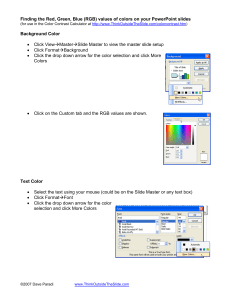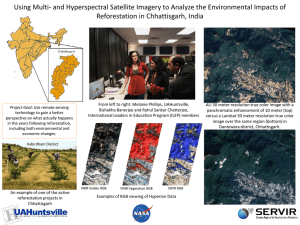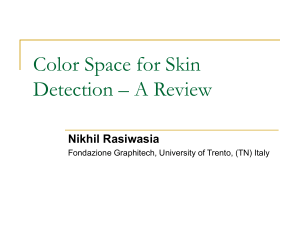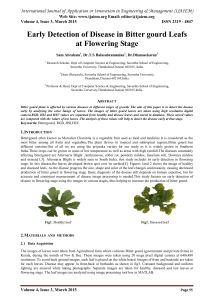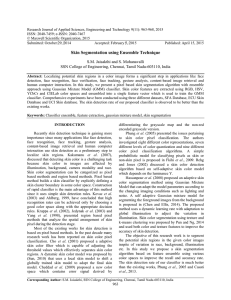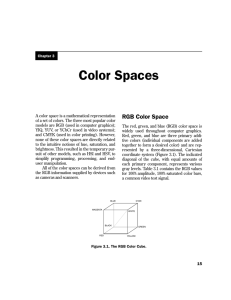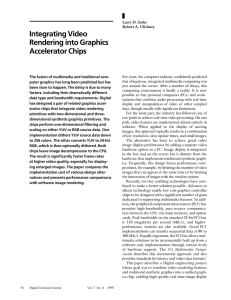Human Skin Detection Using Defined Skin Region
advertisement
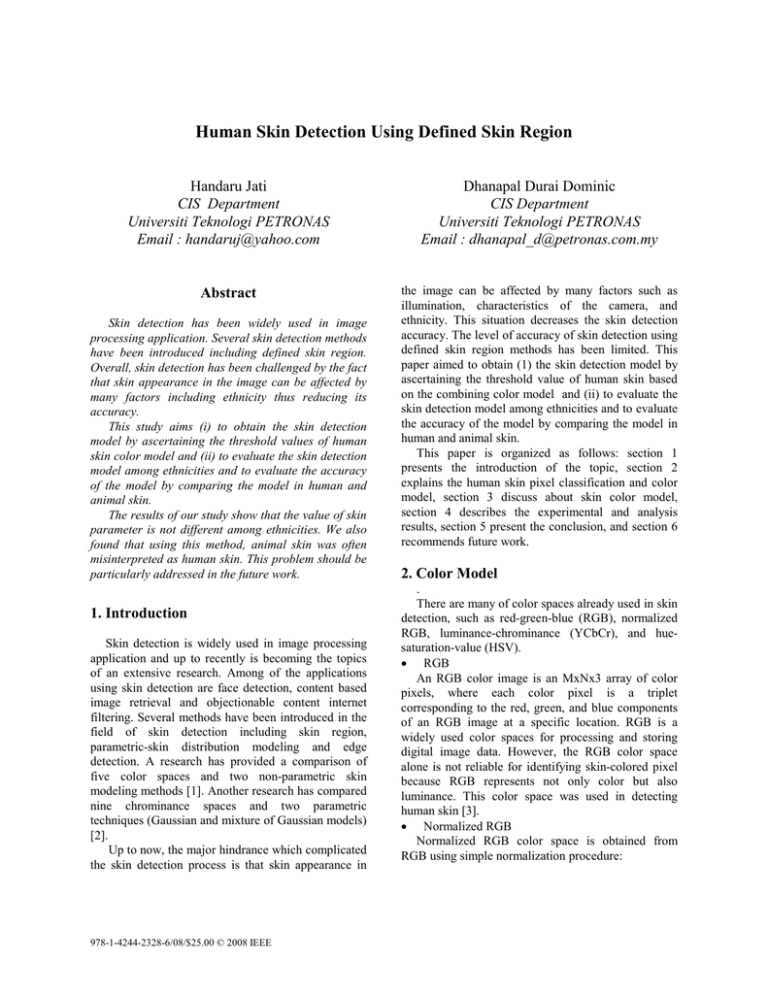
Human Skin Detection Using Defined Skin Region
Handaru Jati
CIS Department
Universiti Teknologi PETRONAS
Email : handaruj@yahoo.com
Dhanapal Durai Dominic
CIS Department
Universiti Teknologi PETRONAS
Email : dhanapal_d@petronas.com.my
Abstract
the image can be affected by many factors such as
illumination, characteristics of the camera, and
ethnicity. This situation decreases the skin detection
accuracy. The level of accuracy of skin detection using
defined skin region methods has been limited. This
paper aimed to obtain (1) the skin detection model by
ascertaining the threshold value of human skin based
on the combining color model and (ii) to evaluate the
skin detection model among ethnicities and to evaluate
the accuracy of the model by comparing the model in
human and animal skin.
This paper is organized as follows: section 1
presents the introduction of the topic, section 2
explains the human skin pixel classification and color
model, section 3 discuss about skin color model,
section 4 describes the experimental and analysis
results, section 5 present the conclusion, and section 6
recommends future work.
Skin detection has been widely used in image
processing application. Several skin detection methods
have been introduced including defined skin region.
Overall, skin detection has been challenged by the fact
that skin appearance in the image can be affected by
many factors including ethnicity thus reducing its
accuracy.
This study aims (i) to obtain the skin detection
model by ascertaining the threshold values of human
skin color model and (ii) to evaluate the skin detection
model among ethnicities and to evaluate the accuracy
of the model by comparing the model in human and
animal skin.
The results of our study show that the value of skin
parameter is not different among ethnicities. We also
found that using this method, animal skin was often
misinterpreted as human skin. This problem should be
particularly addressed in the future work.
1. Introduction
Skin detection is widely used in image processing
application and up to recently is becoming the topics
of an extensive research. Among of the applications
using skin detection are face detection, content based
image retrieval and objectionable content internet
filtering. Several methods have been introduced in the
field of skin detection including skin region,
parametric-skin distribution modeling and edge
detection. A research has provided a comparison of
five color spaces and two non-parametric skin
modeling methods [1]. Another research has compared
nine chrominance spaces and two parametric
techniques (Gaussian and mixture of Gaussian models)
[2].
Up to now, the major hindrance which complicated
the skin detection process is that skin appearance in
978-1-4244-2328-6/08/$25.00 © 2008 IEEE
2. Color Model
.
There are many of color spaces already used in skin
detection, such as red-green-blue (RGB), normalized
RGB, luminance-chrominance (YCbCr), and huesaturation-value (HSV).
• RGB
An RGB color image is an MxNx3 array of color
pixels, where each color pixel is a triplet
corresponding to the red, green, and blue components
of an RGB image at a specific location. RGB is a
widely used color spaces for processing and storing
digital image data. However, the RGB color space
alone is not reliable for identifying skin-colored pixel
because RGB represents not only color but also
luminance. This color space was used in detecting
human skin [3].
• Normalized RGB
Normalized RGB color space is obtained from
RGB using simple normalization procedure:
r=
G
R
R
, g=
, b=
R+G+ B
R+G+ B
R+G + B
The R and G are often labeled as pure colors thus
we can omit B component because this component
does not hold any significant information. This color
space is very popular among the researchers who have
to deal with human skin detection [4], [5].
• HSV
In the HSV, H (hue) defines the dominant color of
an area while saturation measures the colorfulness of
an area in proportion to the brightness [6].
H = arccos
1
( R − G) + ( R − B)
2
( R − G ) 2 + ( R − B)(G − B)
S = 1− 3
V=
min( R, G , B)
R+G+ B
1
( R + G + B)
3
(1)
(2)
p(c | skin) =
(4)
The simple transformation and explicit separation
of luminance and chrominance components make this
color space attractive for skin color modeling [7], [8].
3. Skin Color Model
The skin detector will detect whether the regions in
color image represent human skin or not. Several skin
color modeling methods have been introduced,
including:
• Explicitly defined skin regions.
978-1-4244-2328-6/08/$25.00 © 2008 IEEE
method is the simplicity of skin detection rules that
leads to the construction of very rapid classifier.
• Non parametric skin distribution modeling.
This skin color distribution is created using training
data without derivation of the explicit model of the
skin color, [10] use a histogram based approach to skin
pixels segmentation. The color space is quantized into
a number of bins, each corresponding to particular
range of color component value pairs (in 2D case) or
triads (in 3D case).
• Parametric-skin distribution modeling.
Parametric skin color distribution can be modeled
by an elliptical Gaussian joint probability density
function defined as:
(3)
H varies from 0 to 1 on the circular scale, while S
(saturation) varies from 0 to 1, representing 100
percent purity of the color. There is a research which
mentions that HSV gives the best performance [1].
• YCbCr
The YCbCr color space is widely used in digital
video. Color information is represented as two color
difference component Cb and Cr. Component Cb is the
difference between the blue component and a reference
value, whilst component Cr is the difference between
the red component and the reference value. The
transformation that was used to convert from RGB to
YCbCr is
⎡ Y ⎤ ⎡ 16⎤ ⎡ 65.481 128.553 24.966⎤⎡R⎤
⎢Cb⎥ = ⎢128⎥ + ⎢− 37.797 − 74.203 112 ⎥⎢G⎥
⎥⎢ ⎥
⎢ ⎥ ⎢ ⎥ ⎢
⎢⎣Cr⎥⎦ ⎢⎣128⎥⎦ ⎢⎣ 112 − 93.786 −18.214⎥⎦⎢⎣B⎥⎦
In this category, color space and skin region
boundaries are found empirically [9], for example :
(R, G, B) is classified as skin if: R>95 and G>40 and
B>20 and max{R, G, B} – min{R, G, B}>15 and
R − G >15 and R>G and R>B. The advantage of this
1
2π ∑ s
1/ 2
.e
1
− ( c − μ s )T ∑ −s 1 ( c − μ s )
2
(5)
Where c is a color vector and μ s and ∑ s are the
distribution parameters (mean and covariance matrix
respectively). The model parameter are estimated from
the training data by
μs =
∑s =
•
1
n
n
∑ cj
(6)
j =1
1
n −1
n
∑ (c
j
− μ s )(c j − μ s ) T
(7)
j =1
Edge Detection.
Edge detection plays an important role in image
analysis with the assumption that human skin areas in
the digital image are very plain and have no edges.
The basic idea behind edge detection is to find places
in an image where the intensity changes rapidly using
one of two criteria (1) find region of the image where
the first derivative of the intensity is greater in
magnitude than a specified threshold, and (2) find a
region of the image where second derivative of the
intensity has a zero crossing. Detecting edge of the
image will significantly reduce the amount of data and
filters out useless information and also preserving
important structural in the image. There are six edge
detectors (Sobel, Prewitt, Roberts, Laplacian of a
Gaussian, Zero-Crossings Detector, and Canny) which
can be used in skin detection.
4. Experiments description and results
A practical system was implemented using
MATLAB 7.3. The first step was the initializing of the
skin detection module. More than 500 human and
animal skin samples were used in this research. We
manually cropped human skin and animal skin in the
same size (16x16 pixels images) and all the samples
are pure skin areas. The next step was finding the
parameter values of the sampling which consist of hue,
saturation, Cb, and Cr. The final step in determining
the skin value threshold was estimating the mean of the
color distribution in chromatic color space. Those
values were presented in Table 1.
Table 1. Mean Values of Skin Parameter
Race
Asia
Europe
Black
Animal
H
0.08
0.11
0.09
0.15
S
0.31
0.43
0.44
0.33
Cb
109.00
105.00
112.00
116.00
Cr
148.00
156.00
151.00
139.00
The color distribution of skin color among people
from different ethnicities was found to be clustered in
a small area of the chromatic color space. Skin colors
of different ethnic were very close whilst they only
differed in the intensities. The background lightning in
the picture has a big effect on the skin color.
Original
42.93% (CbCr)
57.22% (H)
42.93% (HCbCr)
Figure 2. Human Skin Detection Using Skin
Region Method
In this experiment, we used explicitly defined skin
region method. Based from the mean value of the
parameter collected from the sample, the span of the
value were:
100 < Cb < 150, 130 < Cr < 160
0.01 <H < 1
Using this span of parameter, this method identified
the majority of human skin but still detected animal
skin which the parameter value was similar to human
skin
Original
CbCr
H
HCbCr
Figure 1. Color Chart for Human Skin
It was very difficult and almost impossible to find
the precise value of skin based on the attribute color
which e used to identify skin pixels and non skin pixels
for the entire image.
Figure 3. Animal Skin Detection using Skin
Region Method
The result of this study shows that hue parameter
and CbCr parameter proved to be less effective
whenever it was used solely for determining skin
978-1-4244-2328-6/08/$25.00 © 2008 IEEE
[3] J. Brand, Mason, J, "A comparative assessment of three
approaches to pixel level human skin detection," In Proc of
the International Conference of Pattern Recognition, 2000.
pixels. Although it found skin pixel in the picture, the
percentage of non skin picture detected as a human
pixel when hue was used 57.223 (H) was bigger than
when CbCr and combination of HCbCr method were
used (42.93). The combination method also worked
well for determining a skin pixel in the animal skin,
which has similar value with human skin.
[4] D. Brown, Cra, I., And Lewthwaite, J., "A som based
approach to skin detection with application in real time
systems," In Proc. Of the british Machine Vision Conference,
2001.
5. Discussion and Conclusion
[5] J. Yang, Lu, W., and Weibel, A, "Skin color modeling
and adaptation," In Proceedings of ACCV, pp. 687-694,
1998.
There are too many outside factors such as lighting
that can change the apparent color of skin, and of
course, different people have different colored skin. In
addition, objects in the background may be the same
color as a person's skin and there is no clear way of
telling the difference using these methods. However, if
these methods must be used, it is wise to use a
combination of color-related factors as the red, green,
and blue values of a pixel are not enough. By adding
hue, saturation, and intensity, a more defined idea of
skin color can be formed.
Skin colors among different ethnicities are not
significantly different. It only differs in intensities.
Background lightning in the picture can have a big
effect on what color of the skin. If we implement
narrow threshold value, then the amount of segmented
skin region will decrease. Mean while, if we setup
wide threshold value then non human skin pixels will
be detected as a human skin region. This problem
should be particularly addressed in human skin
detection especially when the defined skin region is
employed.
6. Future work
To address the accuracy problem in skin detection
using defined skin region skin detection, we
recommend that human body recognition should also
use other method such as human body shape detection
in conjunction with skin detection.
7. References
[1] B. D. Zarit, Super, B.J, and Ouek, F.K.H, "Comparison
of five color model in skin classification," ICCV-Int’l
Workshop on recognition, analysis and tracking of faces
and gestures in Real Time System, 1999.
[2] A. S. Terrillon J., "Comparative Performance of
Different Chrominance Spaces for Color Segmentation and
Detection Of Human faces in Complex Scene Image," 1999.
978-1-4244-2328-6/08/$25.00 © 2008 IEEE
[6] C. A. Poynton, "Frequently asked question about
colour."
[7] S. L. Phung, Bouzerdoum, A., and Chai, D. , "A novel
skin color model in ycbcr color space and its application to
human face detection," In IEEE International Conference on
Image Processing vol. 1, pp. 289-292, 2002.
[8] B. Menser, and Wien. M, "Segmentation and tracking of
facial regions in color image sequences," In Proc.SPIE
Visual Communications and Image Processing, pp. 731-740,
2000.
[9] P. Peer, Kovac, J., and Solina, F, "Human Skin Color
Clustering For Face Detection," In submitted to EUROCON
– International Conference on Computer as a Tool. , 2003.
[10]
S. Birchfield, "Elliptical head tracking using
intensity gradients and color histograms," In Proceedings of
CVPR, pp. 232-237, 1998



